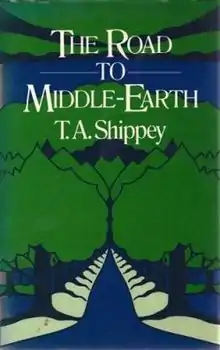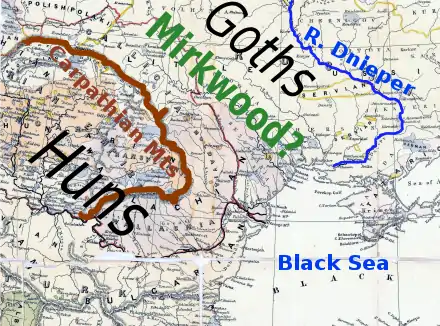The Road to Middle-Earth
The Road to Middle-earth: How J. R. R. Tolkien Created a New Mythology is a scholarly study of the Middle-earth works of J. R. R. Tolkien written by Tom Shippey and first published in 1982. Two further editions extended and updated the work, including a discussion of Peter Jackson's film version of The Lord of the Rings.
 First edition | |
| Author | Tom Shippey |
|---|---|
| Country | United Kingdom |
| Language | English |
| Subject | Middle-earth |
| Genre | Literary criticism |
| Publisher | Allen & Unwin |
Publication date | 1982 |
| Media type | Print (hardback & paperback) |
| ISBN | 978-0-261-10275-0 |
| OCLC | 60000827 |
Book
Synopsis
The book discusses Tolkien's inspiration in creating the world of Middle-earth and the writing of works including The Hobbit, The Lord of the Rings, and The Silmarillion. A recurrent theme is that of Tolkien's detailed linguistic studies (particularly of Old Norse and Old English) and the creation of languages (such as Sindarin and Khuzdul) which feature prominently throughout his works. This was informed by Shippey's tenure at the University of Oxford, teaching the same syllabus as Tolkien at a time when Tolkien still spent time there.[1]

The book begins by explaining Tolkien's philology, his belief in its ability to show what happened as the Gothic empire fell in the 4th century, and his feeling that if he reconstructed an imagined past on such foundations, it would not be wholly false. It then examines the origins of The Hobbit, how Tolkien rebuilt a picture of Elves and Dwarves from the available clues, and from the different ways of speaking of each race, how he ended up writing a richly-characterised story. Three chapters then explore The Lord of the Rings, its map-based plot, its elaborate interlacement of narrative threads, and its underlying mythical and Christian themes. A chapter examines The Silmarillion's origins and structure; another looks at Tolkien's minor works.
An appendix discusses Tolkien's many sources, from the Elder Edda and Beowulf through to the many languages that Tolkien knew. Also attached are four of Tolkien's "asterisk" poems, written to appear to be the ancient origins of more recent works: for instance, Ofer Widne Garsecg is stated by Tolkien to be "An Old English version of 'Twas in the broad Atlantic in the equinoctial gales / That a young fellow fell overboard among the sharks and whales'". Two of the poems concern the Birch tree, symbolising to Tolkien the "B" stream of English studies at Oxford, which covered "Lang[uage]" (including Old English) as opposed to "Lit[erature]" (including Shakespeare).
In the third edition, the book concludes with a chapter on Peter Jackson's film versions; it notes their enormous popular and commercial success, and considers how far the films are faithful to the book. In Shippey's view, the films tend both to "democratisation" and to "emotionalisation" of the narrative, though he welcomes the fact that Jackson has brought a fresh audience to Tolkien's work.[2]
Publication history
In Great Britain, the book was first published by Allen & Unwin in 1982. The book is published by Houghton Mifflin in the United States. The second edition, published by HarperCollins in 1993, included discussion of the 12-volume History of Middle-earth edited by Tolkien's son Christopher Tolkien. The third edition, published in 2003, added a chapter on Peter Jackson's film version. A Polish edition was published in 2001 by Wydaw. Zysk i S-ka at Poznań. A Spanish edition was brought out by Planeta-De Agostini in Barcelona in 2002. A Russian edition appeared in 2003, published by Limbus Press of Saint Petersburg. A German edition was published by Klett-Cotta in Stuttgart in 2018.[3]
Reception
Jessica Yates, in Mythlore, writes that Shippey, a holder of Tolkien's old professorial chair at Leeds, and a Tolkien fan, had two goals for the book: to explain to instinctive lovers of Lord of the Rings why they are right to do so; and to refute the hostile criticism from literary figures like Edmund Wilson. She states that this second reason explains "the rigorous tone" of the book.[4]
Kirkus Reviews calls the work "In sum: the most useful book on Tolkien since the Carpenter biography". The review describes the book as an "erratically enlightening study", one that sometimes goes into great detail on minute points, but that powerfully sets out a major thesis. This is, states the review, that clues from philological study - Tolkien's profession - of Old English and other languages of that period suggested "the greatness of some hidden pre-literate Northern past", and that Tolkien set about inventing "the world that should have existed for legend to take place in, and constructed the epic that should have lain behind the 'asterisk-world' of philogical conjecture".[5]
Gergely Nagy, in Tolkien Studies, writes that the 2005 revision is "the good old Road", with useful additions. The book was in his view from 1982 "emblematic" of the "source-study" or "comparative study" approach to Tolkien criticism. Nagy notes that the book has been described as "the single best thing written on Tolkien", and calls it "the seminal monograph".[6]
Glen GoodKnight, founder of the Mythopoeic Society and writing in Mythlore, describes The Road to Middle-earth as "the best single book written on Tolkien". He notes that Shippey comments in the preface to the second edition that he had not had to make many changes despite the publication of Christopher Tolkien's detailed The History of Middle-earth.[7]
Charles Moseley, in The Observer, writes that the book demonstrated that Shippey was "one of Tolkien's most acute critics and convincing apologists".[8]
Awards
In 1984 the first edition of the book received the Mythopoeic Scholarship Award in Inklings Studies,[9] an award "given to books on J.R.R. Tolkien ... that make significant contributions to Inklings scholarship."[10]
See also
- J. R. R. Tolkien: Author of the Century, a book by Shippey about Tolkien published in 2000
References
- "Publication information for The Road to Middle-earth". Houghton Mifflin. Retrieved 26 September 2020.
- Shippey 2005, Peter Jackson's Film versions.
- "ti:The Road to Middle-Earth au:Shippey". WorldCat. Retrieved 26 September 2020.
- Yates, Jessica (1984). "The Road Goes Ever On". Mythlore. 9 (4). article 15.
- "The Road to Middle-earth". Kirkus Reviews. 1 April 1983. Retrieved 26 September 2020.
- Nagy, Gergely (2005). "The Road to Middle-earth, Revised and Expanded Edition (review)". Tolkien Studies. 2 (1): 258–261. doi:10.1353/tks.2005.0026. ISSN 1547-3163.
- GoodKnight, Glen (1993). "The Road Goes Ever On". Mythlore. 19 (3). article 14.
- Moseley, Charles (7 October 2000). "A Creature of Hobbit". The Observer. Retrieved 26 September 2020.
- "Mythopoeic Awards - List of Winners". The Mythopoeic Society. Archived from the original on 2014-10-10. Retrieved 2009-09-01.
- "Mythopoeic Awards - About the Awards". The Mythopoeic Society. Retrieved 2009-09-01.
Sources
- Shippey, Tom (2005) [1982]. The Road to Middle-Earth (Third ed.). HarperCollins. ISBN 978-0261102750.